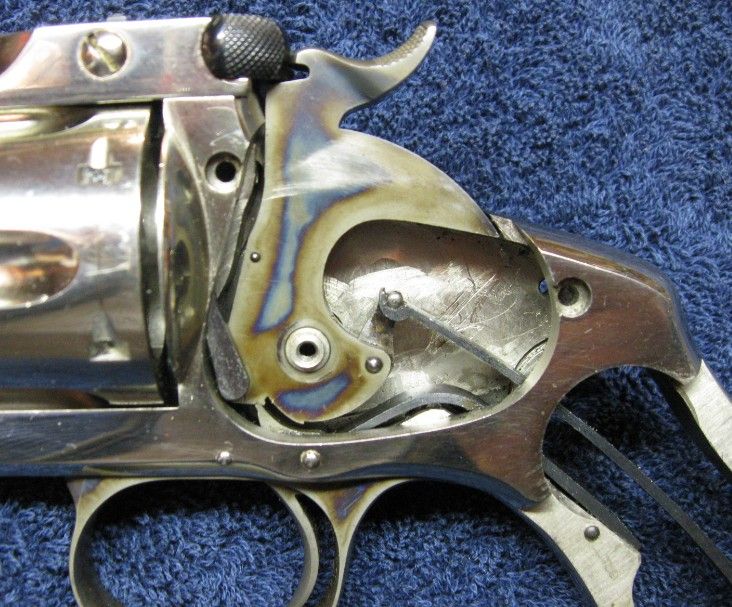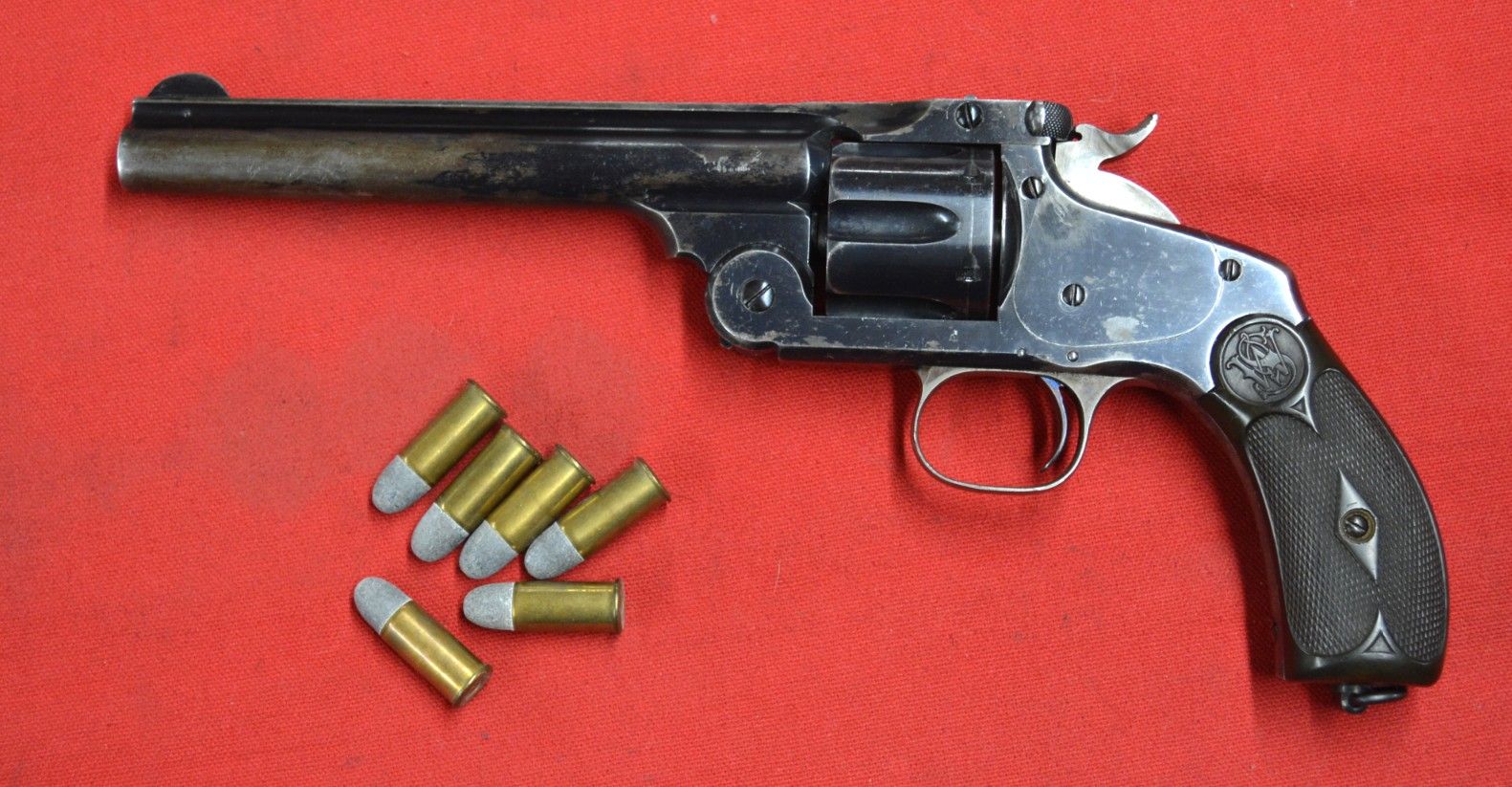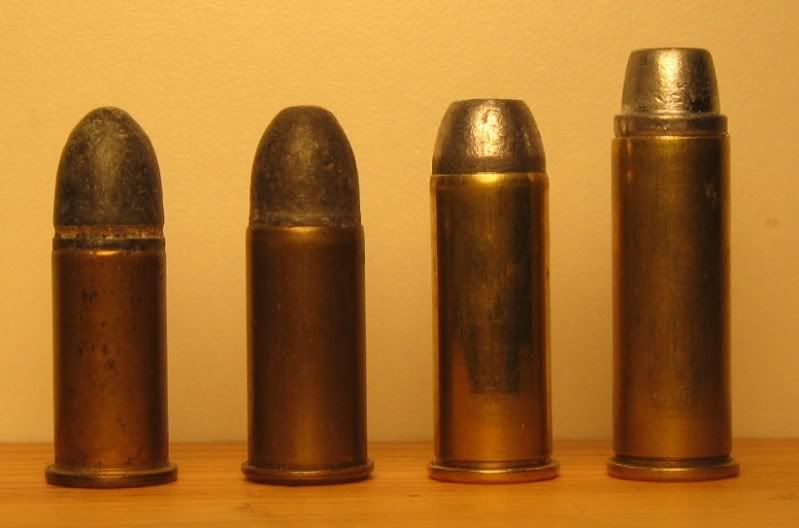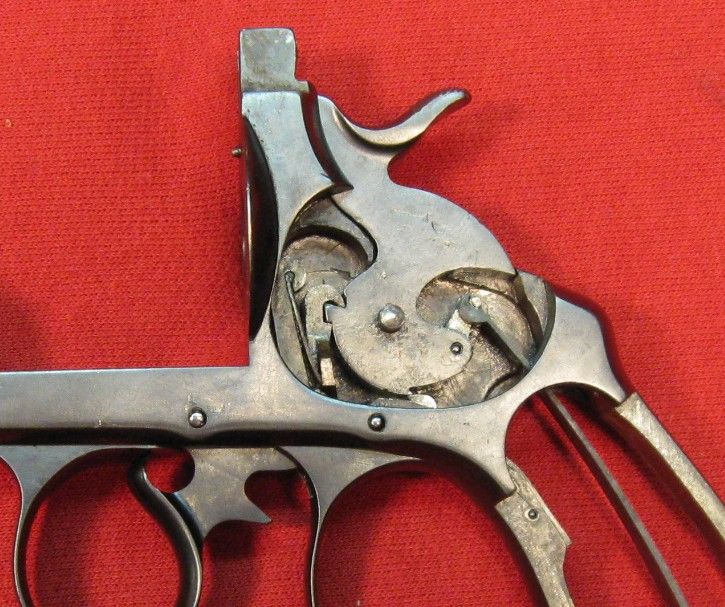So the new model No. 3 frame was the same size as the original No. 3 frame?
Howdy Again
This photo probably answers your question fairly well.
Top to bottom, New Model Number Three made in 1882, Schofield 1st Model made in 1875, and Russian 2nd Model, also made in 1875.

Early in the development of the #3 Top Breaks S&W settled on a cylinder nominally 1 7/16" long with the American model (sorry, I don't have one to show you. Yet). The 1 7/16" long cylinder was just about right for the 44 S&W American cartridge and the later 44 Russian cartridge. This is also the reason S&W had to develop the 45 Schofield cartridge for the Schofield model, a 1 7/16" long cylinder was too short to accommodate the 45 Colt cartridge chambered by the Colt Single Action Army. Smith and Wesson's bread and butter in the early 1870s was the Russian model, all their #3 tooling was set up for 1 7/16" long cylinders. When they approached the Army about a contract, the Army insisted on 45 caliber, but S&W was not about to change all their tooling to make a longer cylinder for an Army contract that might or might not pan out. So the Army told S&W they would accept a shorter 45 caliber cartridge. Whether or not this actually created supply problems is debatable, but it was the correct decision for S&W. S&W eventually produced around 150,000 Russian models, only about 9,000 Schofields. (working off the top of my head here) But if one is working with a large diameter cylinder 1 7/16" long, the major features of the frame are going to be about the same size.
Sure there are plenty of stylistic differences between the frames of the various #3 Top Breaks, things like the big hump on the grip of the Russian model, the slight hump on the NM#3, and the smooth curved grip of the Schofield. The grip of the American model was also curved, much like the Schofield, but it was a bit more straight up and down. The other thing to notice about the #3 design is how the extractor housing under the barrel got shorter and shorter over time, as S&W kept improving and shortening the extractor mechanism. The extractor housing of the American model was the longest of all.
Later S&W did chamber the New Model Number Three and the 44 Double Action for some longer cartridges, such as 44-40 and 38-40, and a 1 9/16" long cylinder was needed for these calibers. The frames of these guns were 'stretched' that extra 1/8" to properly accommodate those calibers. But that extra 1/8" is pretty much the only difference in frame size. Sorry, I don't have any #3s with the longer cylinders, all of mine are chambered for 44 Russian with the exception of the Schofield. But I can usually spot one with the longer cylinder when I see one. I usually go to auctions and gunshops with a tape measure in my pocket.
In the next photo, top to bottom, are the New Model Number Three, Russian, and a 44 Double Action chambered for 44 Russian with a 1 7/16" cylinder. The shape of the double action grip frame is quite similar to the NM#3 grip frame. Not exactly the same, but very similar. Of course, being double action, the lockwork is radically different. Notice the ejector housing of this Double Action is slightly longer than the NM#3, but I have another 44 Double Action with a short ejector housing the same length as the one on this NM#3. In fact, I believe the barrels of the 44 Double Action and the NM#3 were interchangeable. Not 100% sure of that, but I'm pretty sure. Dig the funky trigger and trigger guard shapes. Notice too all the extra slots cut into the Double Action cylinder. More about that in a minute.
So perhaps a grain of salt should be taken when I say all Number Three Top Breaks were the same size. There were basic, obvious differences, but they were all 'pretty much' the same size.
While I'm at it, here are, top to bottom, the lockworks of the Russian, Schofield, New Model Number Three, and 44 Double Action.
Sorry it is a little bit out of focus, but in this photo the hammer is all the way down on the Russian model. You can see the firing pin poking through the frame at the front. (I removed the cylinder for this photo) The half cock notch (it's not really half way), is just behind the trigger sear. The full cock notch is further back. The slanty piece is the hand. I think proper S&W speak calls it a pawl. The curved piece pinned to the frame is the trigger spring. Notice the slot at the top of the hammer. This captures a tab on the barrel latch. In order to break the gun open, the hammer had to go back to the 'half cock' position. This freed the tab on the latch to be lifted, and the bolt popped down when the hammer was in the 'half cock' or loading position, allowing the cylinder to spin freely.

Here is the Schofield lockwork. The hammer is all the way forward, the firing pin is protruding through the frame, and the bolt (cylinder stop) is popped up in the frame. Very similar to the Russian lockwork, except because the barrel latch was frame mounted, there was no slot on the hammer to trap the latch. Instead, the hammer had to be brought back to the half cock position for the flat at the top of the hammer to allow the latch to be pulled back far enough to open the gun. Bringing the hammer back to half cock also withdrew the bolt into the frame so the cylinder could spin freely.

The New Model Number Three was the piece de resistance of S&W Top Break design. The mechanism is almost the same as the Russian or Schofield models, excerpt a new wrinkle was added. The NM#3 featured a rebounding hammer. Once the hammer fell, the springs would automatically pop it back slightly. When the trigger was released, the sear would then pop into a very small notch. That is the position the hammer is in now. The firing pin has been pulled back into the frame, and the sear is resting in the tiny, I'll call it a 'safety notch'. The bolt is still in the popped up position, keeping the cylinder locked, the slot at the top of the hammer is still trapping the barrel latch. In order to break the gun open, the hammer still has to be brought back to the half cock position, withdrawing the bolt into the frame and allowing the barrel latch to be lifted. Clearly, the rebounding hammer feature was added as a safety feature, but because that 'safety notch' is so tiny, and the sear is so thin, I would never trust it to prevent an accidental discharge if the hammer happened to receive a blow with a live round under the hammer. I suspect the sear would break and the gun would discharge. Interestingly enough, the target model New Model Number Threes did not have the rebounding hammer.

Finally, here is the 44 Double Action lockwork. The claw shaped piece is the front sear. It rotates the hammer back when the trigger is pulled. There is a separate sear for single action fire. The cylinder locking system is bizarre. There is a conventional bolt that pops up and locks the cylinder when the hammer is cocked, or when the trigger is pulled double action. There is a knob on the front of the trigger that pops up when the trigger is released. This knob engages the front row of locking slots you can see on the cylinder in the earlier photo. The vertical slots on the cylinder are clearance cuts so the knob on the front of the trigger will not interfere with the cylinder if the gun is closed without a chamber lined up with the bore. The 38 Double Action Top Breaks originally had the same system, but they were later changed to a simpler one bolt system. The 44 Double Action never received that update.








